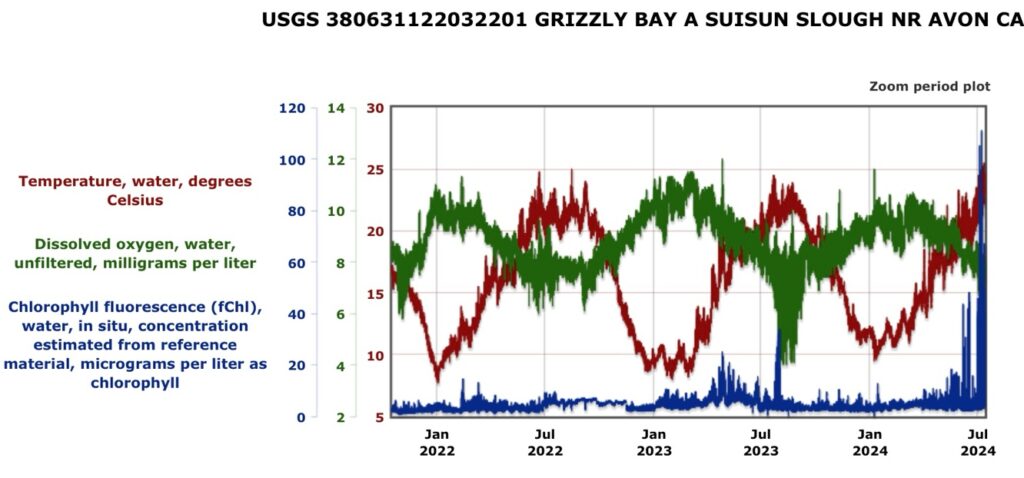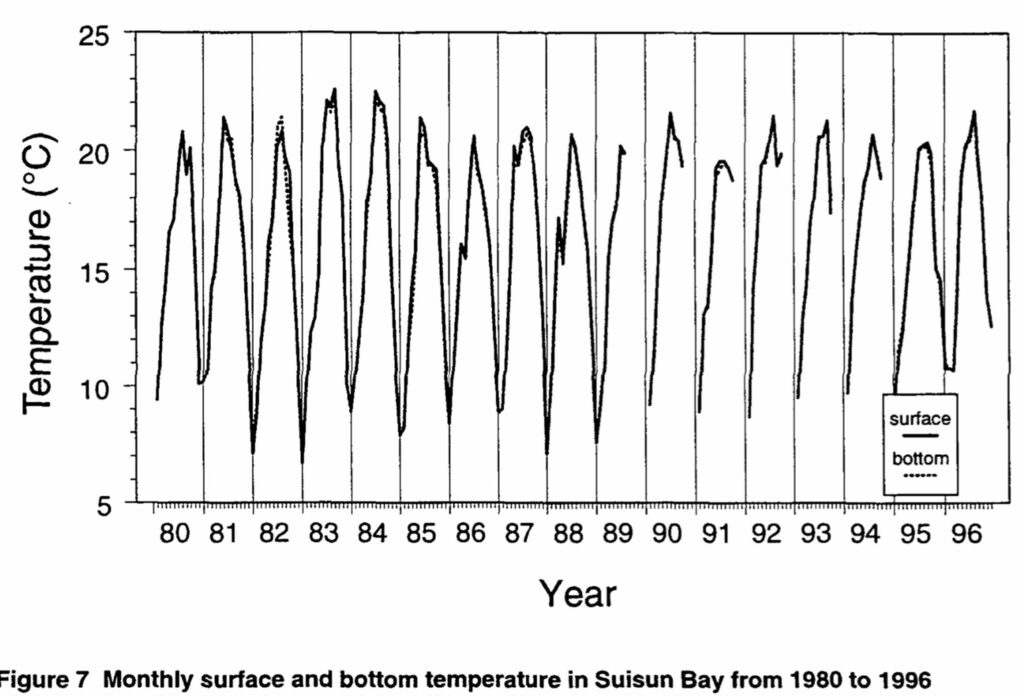This is a follow-up to a July 8 post on summer 2024 aquatic habitat conditions in the Bay-Delta Estuary. In this post, I focus on mid-July conditions after yet another summer heat wave. I am concerned that conditions are building for yet another sturgeon die-off this summer. Sturgeon mortality is caused by excessively warm water and algae blooms that eventually lead to rapid algae die-off and associated extremely low dissolved oxygen levels (<5 mg/l) throughout the Bay. Such conditions became acute in summer of drought year 2022 and led to the deaths of thousands of adult sturgeon and other Bay fishes.
Conditions in the Bay are already worse this year at the beginning of summer than in 2022 or 2023 (Figure 1). Water temperatures and chlorophyll concentrations are higher, with dissolved oxygen concentrations falling.

Of greatest concern is the already warm water temperatures in parts of the Bay-Delta despite a relatively high Delta inflow with cooler than normal water temperatures (Figure 2). Water temperatures have exceeded 75oF in the west Delta and east Bay low-salinity zone of the estuary (the prime summer habitat of endangered Delta smelt). Water temperatures of 75-77oF (24-25oC) are lethal to Delta smelt.1
In the decades of the 80’s and 90’s, Delta smelt were still relatively abundant although suffering severely in drought years. Water temperatures rarely exceeded 70oF in Suisun Bay (Figure 3). The reason for the difference is likely a combination of higher air temperatures, lower Delta outflows, and higher Delta water diversions in recent decades. In some years lower, warmer Delta inflows aggravate the problem, but not this year (2024) when inflows were kept high to sustain high Delta water diversions.
One area of warming of the lower Sacramento River channel that deserves special attention is the north Delta below the Delta Cross Channel and Georgianna Slough bifurcation. Much of the water destined for south Delta exports is diverted from the Sacramento River through these channels. In the reach below the diversion channels the river temperature increased several degrees (73 to 76oF) in early July. One explanation is that of the 21,000 cfs Delta inflow at Freeport only 5000 cfs remained below the entrance to Georgianna Slough (Figure 4). The missing flow passed into Georgianna Slough, the Delta Cross Channel, and Miners/Steamboat Sloughs, all reaches where the flow warmed to even a greater degree. At Rio Vista and the west Delta, where the water exits the Delta for the Bay, water temperatures reached 76oF as total outflow increased to 10,000 cfs from the 5000 cfs in the lower Sacramento River channel and 5000 cfs returning warmer water from the Cache Slough complex and San Joaquin River channel. Waters in the wide, large, open channel at Rio Vista also slowed, with a stronger influence of the tides, especially during the recent heat waves (Figure 5).
I contend that the high rate of Delta water diversion at Georgianna Slough and the Delta Cross Channel contributed to the warming by forcing cooler water from the Sacramento River Delta inflow into the central Delta where it warmed or was diverted.
I recommend closing the DCC and reducing Delta water diversions in July and August to reduce Bay-Delta water temperatures and minimize the potential for excessive algae blooms, low dissolved oxygen, and sturgeon die-offs in the Bay this summer. I further recommend that Delta inflows be sufficient to maintain water quality standards for water temperatures in the lower Sacramento River above the Delta.




- It is unlikely Delta smelt would survive extended periods above 72oF; they would not do well in water temperatures above 68oF. ↩
